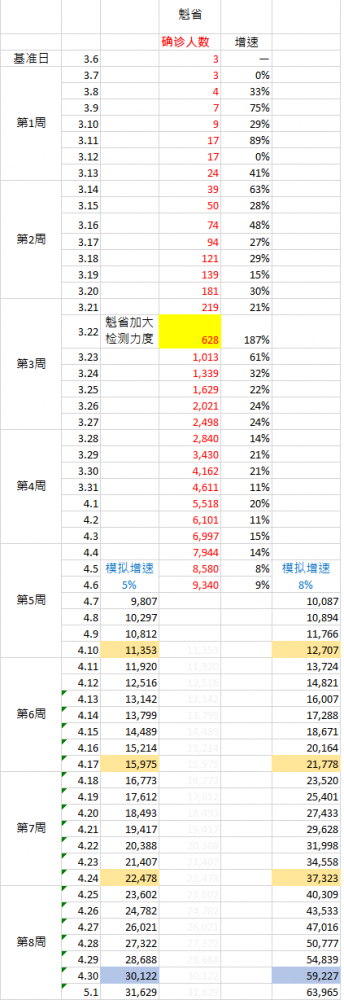黄海懿 - www.huanghaiyi.com
加国财务顾问(保险、基金)魁省政府刚刚公布了疫情发展趋势的预测,预计4月30日前,在乐观模式下,将有29,212人感染;在悲观模式下,将有59,845人感染。
我们期待着魁省在官员们的不懈努力下呈现乐观模式,同时也看到,即使是预计中的“悲观模式”,也已经是相当地乐观了,那意味着未来的3周中,每天都能控制在增幅8%之下,而这,是过去几周内所能呈现的最好水平。“有志者事竟成”,希望我们能看到一条控制良好的轨迹。

在这里我不禁要写一位对我影响颇深的老领导,虽然他不老,年芳18……有次出差前,老领导让我算道数学题,两点之间哪条线距离最短?这还用说吗,莫非其中有诈?果然,正当我犹豫道难道不是直线吗,看到了他那一抹得意的笑~~噢不,是微微一笑,老领导自然是正面人物啦,他语重心长地跟我说:两点之间距离最短的是阻力最小的那条线,不要只想技术问题,更需要评估各方阻力……
后来我一直觉得这就像唐僧师父赠与悟空的神咒一样,这个虽不会让我头皮发紧,但是此后很多年碰到事的时候,总会想起他的话。此乃真真正正的至理名言,在此也将这神句转赠予咱们这些朋友们~~
之所以说这些,是因为四周前我曾用两条固定增速的曲线打了个区间预测加国/魁省未来感染人数,有兴趣的朋友们有时间有心情时excel一试即知……然而魁省政府这么说,可谓用心良苦,这正是阻力最小的方向。
数据模型重不重要?其实与民众的心理、与社会的稳定相比,数据也就没那么重要了。我们的社会由多元的人们构成,有善良友好的人们,也有伤害别人的人,有情绪稳定冷色调的人,也有精神方面特别需要慰籍的人……在疫情之上,的确需要先保证社会情绪的稳定、避免犯罪和骚乱。还有最近从人道主义角度考虑释放了很多在押者(只是被判了几年,又不是判死刑,集中监禁让他们面临着COVID-19的生命威胁呢),同时,省长也向联邦请求调军队来增援。
这些就是我们所看到的目前预测的原因,那么该如何实现这个无论是乐观中的乐观的乐观预测,或是乐观中的也没多悲观的悲观预测呢?那需要魁省官员们解决当下存在的多类产生交叉感染的症结所在,就会降低感染人群的增速。8%意味着什么?意味着一张考试卷几乎处处完美,只有个别的几处错误。若卷子上小错大错不断,那就得靠神仙来帮忙啦~~
魁省产生交叉感染的原因,有这样几点:
1、 COVID-19的检测点基本都建在人口密集居住区、大型超市旁、交通枢纽附近,有的离居民房仅几米的距离。按照世卫组织3月底发的报告病毒为气溶胶传播,麻省理工的实验表明咳嗽能飞到5米、喷嚏打出8米,病毒在空气中存活3小时......Montreal正在计划新增一些检测点,不当的选址会制造出一些意料之外的大规模交叉感染的机会。
2、 医护人员相当于为我们冲锋的军队,最大可能地保存他们,我们平民才会安全。目前医护人员有没有被允许戴口罩、戴护目镜、穿防护服,都要看医疗体系的官员们能不能及时修订工作防护标准。如果还在沿袭疫情前的做法,好端端培养了多年的医护人员都在冒着成倍的风险呢,有些可能会此倒下~~ 还有好心捐助医疗资源的朋友们也请留意一下,如果质量出现争执是否会涉及法律风险?
3、 地铁系统由于其通风的问题无法解决,交叉感染的风险太大了。不知官员们对这个会不会采取行动。
4、 还有就是如何帮助孤寡、年纪大和单亲家庭的人们居家隔离时的情况。
咱们的华人朋友里那些与媒体朋友、政府官员有一定的联系,如果能与他们在这些事上有一定的交流,那真是在大大地帮助民众,同时也帮自己了。至于和我一样人微言轻的朋友们,可在自觉合适的情况下与其他族裔的朋友交流、论坛上讨论,或去省长Francois Legault的Twitter上提冷静合理的建议。
这几天身边的华人朋友们(市中心的艺术家,Justine,Chad等)总结了些挺好的建议,已译成英文版,朋友们可挑选其中的几条贴一下,如果能有媒体朋友们在市长省长新闻发布会上提问那是最好!省长的推特留言有字数限制,文章的最后部分已将建议都简化到字数限制之内了,仅供朋友们参考。感谢艺术家和法裔好友将建议做成了在我看来很漂亮的英文版,还有多伦多的好友贡献了很多的时间和精力!在此非常感谢他们!

Part 1, Questions for the press
第1部分,供媒体提问
1. In choosing Covid-19 test site (Place-des-arts and Cote saint-Luc), were any infectious disease experts consulted to avoid further cross infection? What are the selection criterions forCOVID-19 testing sites?
在选择Covid-19测试地点(Place-des-arts和Cote saint-Luc)时,是否咨询过任何传染病专家以避免进一步的交叉感染?COVID-19测试地点的选择标准是什么?
2. MIT and WHO reports state that COVID-19 spreads by droplet-borne airborne transmission and that coughing and sneezing can project droplets 5-8 meters? The COVID-19 testing sites in downtown Montreal and Cote St-Luc all set up in the densely populated areas, exit of Metro, large supermarkets, and underground/on-ground shopping centers. Can these test sites therefore accelerate infection?
麻省理工学院和世界卫生组织的报告指出:COVID-19通过飞沫传播通过空气传播,咳嗽和打喷嚏可以使飞沫传播5-8米吗?Montreal和Cote St-Luc的COVID-19测试地点都设在人口稠密的地区,地铁出口,大型超市和地下/地面购物中心。这些检测点会因此加速感染吗?
3. Why is the Montreal downtown COVID-19 test site (Place-des-arts) also positioned as the drive-thru test, non-appointment needed? What is the criterions drive-thru testing sites? Should drive-thru be in open areas, sparsely populated areas, or in areas with underdeveloped rather than crowded downtown ones?
为什么Montreal市中心COVID-19测试地点Place-des-arts也被定位为驱车式直通测试?直通测试站点的标准是什么?开车穿越应该在开阔地带,人烟稀少的地区,还是在不发达而不是在拥挤的市区?
4. Does locating the Place-des arts COVID-19 test site near public transportation hub encourage symptomatic people to use metro and buses? Does this expand the cross-infection including employees of the medical system, Hydro-Quebec and government employees who are still working and need to use the public transportation system?
将Place-des arts COVID-19测试地点放在公共交通枢纽附近是否会鼓励有症状的人们乘坐地铁和公共汽车?这是否会扩大交叉感染范围,包括医疗系统员工,魁北克水电公司和仍在工作且需要使用公共交通系统的政府员工?
5. Has the Quebec government considered the possibility of testing and mild treatment in homes, so that the hospital is mainly responsible for serious cases?
魁北克政府是否考虑了在家中进行测试和轻度治疗的可能性,以使医院主要负责严重病例?
6. How should the ventilation system of the subway/Metro address COVID-19 infectivity? Do buses with open windows keep the air flowing and reduce the risk of cross infection? Is it useful to encourage everyone to drive or take buses rather than the metro?
地铁的通风系统如何应对COVID-19的传染性?敞开窗户的公共汽车能保持空气流通并降低交叉感染的风险吗?是不是需要鼓励人们开车或乘公共汽车而不是乘地铁?
7. Are the medical care regulations and community service regulations currently being implemented modified, to adapt the high infectivity of COVID-19? If the government does not have time to modify the corresponding rules now, the government should increase the flexibility of the regulations, at least allowing medical care and community service personnel to increase their own protection and reduce the risk of infection.
目前是否正在修改医疗法规和社区服务法规,以适应COVID-19的高传染性?如果政府现在没有时间修改相应的规则,则政府应增加法规的灵活性,至少应允许医疗保健和社区服务人员增加自己的保护并降低感染风险。
8. In the case of closure and travel restrictions, on-street parking is working medical staff, government power company personnel, supermarket service personnel, community service personnel, doctors and citizens to see the doctor or purchase foods. To reduce people's exposure to the outdoors, has the government considered temporarily exempting parking fees and relaxing parking restrictions?
在关闭和出行限制的情况下,路边停车的往往是在职医务人员,政府电力公司人员,超市服务人员,社区服务人员,医生,和看医生和购买食物的市民。为了减少人们在室外的暴露,政府是否考虑暂时免收停车费和放宽停车限制?
9. Is there any special assistance that could be provided for people who don't live in a home that lends itself well to one symptomatic member being quarantined? For example, people don't have a separate or spare room to be isolated completely from other family members, or single parents raising young children alone without any family members, friends, or support organizations. If such kind of people infect COVID-19, how should them isolate themselves from their children, and how to maintain the children's daily lives? When people under quarantined have no food to eat, what should they do?
如果有症状患者居住在没有单独隔离房间的房屋中,是否可以提供特别援助?还有如何为单亲父母独自抚养年幼的孩子的人们提供援助,他们没有任何家庭成员,朋友或支持组织。当感染了COVID-19,他们应如何与孩子隔离,如何维护孩子的日常生活?当被隔离的人没有食物可吃时,该怎么办?
10. Is it possible that Montreal prepares mild patient large-scale isolation place and give them the treatment, instead of staying at home and continuously infecting other family members? The United States, Germany, and Italy all have prepared large-scale isolation sites. When many stay home isolation cases happen, the rate of community infection will be accelerated.
Montreal是否有可能为轻症患者提供大规模隔离场所并为其提供治疗,而不是呆在家里继续感染其他家庭成员?美国,德国和意大利都准备了大规模的隔离地点。当发生许多留在家中隔离的情况时,社区感染的速度将会加快。
11. Hydroxychloroquine sulfate has been used to treat COVID-19 in many countries such as the United States, India, and France, etc. Has Canada considered allowing the patient to take this medicine?
在许多国家,例如美国,印度和法国等,已经使用硫酸羟氯喹治疗COVID-19。加拿大是否考虑过允许患者服用这种药物?
Part 2: Questions for Francois Legault's Twitter (with words limit) :
可在省长推特留言的,若朋友们认同哪条的想法哈~~
1. In choosing Covid-19 test site (Place-des-arts and Cote saint-Luc), were any infectious disease experts consulted to avoid further cross infection? What are the selection criterions for COVID-19 testing sites?
在选择Covid-19测试地点(Place-des-arts和Cote saint-Luc)时,是否咨询过任何传染病专家以避免进一步的交叉感染?COVID-19测试地点的选择标准是什么?
2. MIT and WHO reports state that COVID-19 spreads by droplet-borne airborne transmission and that coughing and sneezing can project droplets 5-8 meters? Montreal COVID-19 testing sites set up in the densely populated areas, exit of Metro; they accelerate infection?
麻省理工学院和世界卫生组织的报告指出:COVID-19通过飞沫传播通过空气传播,咳嗽和打喷嚏可以使飞沫传播5-8米吗?Montreal和Cote St-Luc的COVID-19测试地点都设在人口稠密的地区,地铁出口,大型超市和地下/地面购物中心。这些检测点会因此加速感染吗?
3. Why is the Montreal downtown COVID-19 test site positioned as drive-thru test, non-appointment needed? What is the criterions drive-thru testing sites? Should it be in open areas, sparsely populated areas, or in underdeveloped areas rather than crowded downtown?
为什么Montreal市中心COVID-19测试地点Place-des-arts也被定位为驱车式直通测试?直通测试站点的标准是什么?开车穿越应该在开阔地带,人烟稀少的地区,还是在不发达而不是在拥挤的市区?
4. Does locating Place-des arts COVID-19 test site near public transportation hub encourage symptomatic people to use metro & buses? Does this expand cross-infection including employees of the medical system, Hydro & government employees who use public transportation?
将Place-des arts COVID-19测试地点放在公共交通枢纽附近是否会鼓励有症状的人们乘坐地铁和公共汽车?这是否会扩大交叉感染范围,包括医疗系统员工,魁北克水电公司和仍在工作且需要使用公共交通系统的政府员工?
5. Has the Quebec government considered the possibility of testing and mild treatment in homes, so that the hospital is mainly responsible for serious cases?
魁北克政府是否考虑了在家中进行测试和轻度治疗的可能性,以使医院主要负责严重病例?
6. How should the ventilation system of the subway/Metro address COVID-19 infectivity? Do buses with open windows keep the air flowing and reduce the risk of cross infection? Is it useful to encourage everyone to drive or take buses rather than metro?
地铁的通风系统如何应对COVID-19的传染性?敞开窗户的公共汽车能保持空气流通并降低交叉感染的风险吗?是不是需要鼓励人们开车或乘公共汽车而不是乘地铁?
7. Are medical care regulations &community service regulations currently being modified, to adapt COVID-19 high infectivity? Government should increase regulations flexibility if have no time to modify, should allowing medical & community personnel to increase protection.
目前是否正在修改医疗法规和社区服务法规,以适应COVID-19的高传染性?如果政府现在没有时间修改相应的规则,则政府应增加法规的灵活性,至少应允许医疗保健和社区服务人员增加自己的保护并降低感染风险。
8. Now travel restrictions,on-street parking is working medical staff,supermarket &community service personnel, citizens to see doctor or purchase foods. To reduce exposure to outdoors, may consider temporarily exempting parking fees & relaxing parking restrictions?
在关闭和出行限制的情况下,路边停车的往往是在职医务人员,政府电力公司人员,超市服务人员,社区服务人员,医生,和看医生和购买食物的市民。为了减少人们在室外的暴露,政府是否考虑暂时免收停车费和放宽停车限制?
9. Any special assistance for people who don't have conditions of home quarantine(separate rooms) or single parents raising young children alone without family members/friends, how should they isolate themselves from kids? How to maintain children's daily lives?
如果有症状患者居住在没有单独隔离房间的房屋中,是否可以提供特别援助?还有如何为单亲父母独自抚养年幼的孩子的人们提供援助,他们没有任何家庭成员,朋友或支持组织。当感染了COVID-19,他们应如何与孩子隔离,如何维护孩子的日常生活?当被隔离的人没有食物可吃时,该怎么办?
10. Is it possible that Montreal prepares a mild patient large-scale isolation place and give them treatment, instead of staying at home, continuously infecting other family members? When many stay home isolated cases happen, rate of community infection will be accelerated.
Montreal是否有可能为轻症患者提供大规模隔离场所并为其提供治疗,而不是呆在家里继续感染其他家庭成员?美国,德国和意大利都准备了大规模的隔离地点。当发生许多留在家中隔离的情况时,社区感染的速度将会加快。
11. Hydroxychloroquine sulfate has been used to treat COVID-19 in many countries such as the United States, India, and France, etc. Has Canada considered allowing the patient to take this medicine? Thanks!
在许多国家,例如美国,印度和法国等,已经使用硫酸羟氯喹治疗COVID-19。加拿大是否考虑过允许患者服用这种药物?




